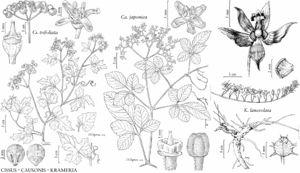Herbs or shrubs, perennial, mostly evergreen. Leaves alternate, simple [3-foliolate]; stipules absent; petiole absent [present]; blade margins entire; venation pinnate with major veins ± longitudinal. Inflorescences terminal, secund racemes [panicles], or axillary, solitary flowers. Flowers bisexual, bilaterally symmetric; perianth and androecium hypogynous; hypanthium absent; sepals [4–]5, distinct; petals [4–]5, proximal 2 distinct, modified into fleshy oil-secreting structures flanking ovary, distal [2–]3 distinct or connate basally, petaloid, forming flag adaxial to ovary; nectary absent; stamens [3–]4, usually distinct, sometimes connate basally, free and inserted at base of petaloid petals or adnate to connate bases of petaloid petals; anthers dehiscing by terminal pores; pistil 1, 2-carpellate but appearing 1-carpellate by suppression of second carpel, ovary superior, 1-locular, placentation apical; ovules 2 per locule, anatropous; style 1; stigma 1. Fruits capsules, tardily and irregularly dehiscent, spinose. Seeds 1 per fruit.
Distribution
United States, Mexico, West Indies, Central America, South America.
Discussion
Genus 1, species 18 (4 in the flora).
Krameria flowers do not produce nectar, and pollen is rarely collected. The flowers reflect their obligate pollination system with oil-collecting bees (B. B. Simpson 1989). Two petals are modified into fleshy structures that secrete oils, forming blisters under the cuticle (Simpson et al. 1977). Female bees rupture the cuticle (J. L. Neff and Simpson 1981) and collect the oils for nest linings (S. B. Vinson et al. 1996) and larval provisions.
All species of Krameria examined are hemiparasitic with roots attaching to a wide range of hosts (W. A. Cannon 1910; J. Kuijt 1969). There is no evidence (B. B. Simpson 1991) that root extracts are medicinally effective in treating bleeding and blood disorders (H. Ruiz López 1799), nor that a tea made from the roots causes esophageal cancer (J. F. Morton 1968).
Because the zygomorphic flowers of Krameria superficially resemble those of caesalpinioid legumes or members of the Polygalaceae, Krameria has been placed in these families; it was convincingly segregated into its own family based on cytological studies (B. L. Turner 1958) and reinforced by later anatomical evidence (T. H. Milby 1971). Molecular evidence has shown that the family is sister to, but distinct from, Zygophyllaceae (P. A. Gadek et al. 1996). An infrageneric molecular study of Krameria (B. B. Simpson et al. 2004) showed that the species cluster into four well-supported clades. A biogeographic analysis based on this phylogeny suggested that there were two independent dispersals or vicariant events between North America and South America (Simpson et al.).
